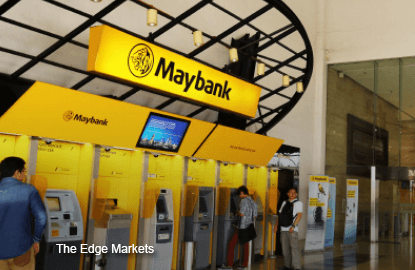
BANKS are in for a rougher ride in the second half as they grapple with falling margins, slower loan growth and, for some, elevated levels of bad loan provisions, amid a slowing economy.
In the just-concluded March-June reporting season, the country’s eight domestic banking groups turned in a mixed bag of financial results, which analysts say were generally dismal. A key theme was a quarter-on-quarter drop in their net interest margins (NIM), which is expected to continue to trend lower.
“The (second quarter) numbers for the banks were not so great ... it’s pointing towards a worst second half,” a banking analyst with a local research house tells digitaledge Weekly.
This prompted a slew of earnings downgrades and share price target cuts on the banks. Many analysts are, however, expected to keep their ‘neutral” calls on the sector, considering the already steep declines in the banks’ share prices.
AMMB Holdings Bhd (fundamental: 1.50; valuation: 2.55) and Alliance Financial Group Bhd (fundamental: 1.50; valuation: 2.25) were seen as the worst performers for the quarter, while Public Bank Bhd (fundamental: 2.80; valuation: 1.80) and Hong Leong Bank Bhd (fundamental: 2.80; valuation: 2.70) were among the better ones.
Some groups, especially regional ones like Malayan Banking Bhd (Maybank) and CIMB Group Holdings Bhd (fundamental: 1.05; valuation: 2.25), saw a slight deterioration in asset quality mainly because of their Indonesian operations. Maybank’s gross impaired loan (GIL) ratio rose marginally to 1.56% as at June from 1.5% three months earlier, while CIMB Group’s rose to 3.3% from 3.2%.
At least two groups — Maybank (fundamental: 1.40; valuation: 2.25) and RHB Capital Bhd (fundamental: 1.50; valuation: 2.10) — have lowered their growth expectations for the full year, even as some CEOs admit that the going will be tough.
“2015 is turning out to be a testing year for the financial services industry,” says group CEO of CIMB Group, Tengku Datuk Zafrul Aziz. “Our stance continues to be a cautious one, in light of the recent moderation of regional economies and softer capital markets.”
“We foresee rough waters ahead,” Hong Leong Bank group managing director Tan Kong Khoon told a press briefing last Wednesday after announcing the bank’s financial results for the full year ended June 30, 2015. He added, however, that the group was “in a very good position” to ride it out.
Maybank lowered its return on equity (ROE) target for the year to 12%-13% from 13%-14% previously, and its overall loan growth target to 8%-9% from 9%-10%. Analysts say RHBCap lowered its loan growth expectations to 6%-7% from 10% before.
“I think banks are bracing for slower loan growth, ongoing NIM compression, difficulty in growing non-interest income and normalisation of credit costs. There’ll be sporadic asset quality issues, especially in corporate loans, that one has to monitor. I’m wary of that, with the slowdown in the economy,” says a banking analyst.
Last Friday, CIMB Group announced a 33% drop in second-quarter net profit to RM639.8 million, on significantly higher loan loss provisions mainly from Indonesia, while revenue improved 12.5% to RM3.83 billion. Its allowance for impairment losses on loans, advances and financing that quarter stood at RM528.95 million compared with RM147.18 million a year ago.
“The results were more or less within my expectations,” says a banking analyst, who adds that the numbers were “distorted” by restructuring expenses and mutual separation scheme costs incurred by the group. CIMB’s business-as-usual net profit for the second quarter was 12.1% higher at RM877 million than that in its first quarter.
Tengku Zafrul, however, told analysts later that provisions for the Indonesian operations have “peaked”, suggesting that provisions in the second half will be lower.
RHBCap, which also unveiled its second-quarter results last Friday, saw net profit fall 6% to RM524.6 million from a year ago, on higher interest expense and the absence of impairment losses written back on other assets. Revenue, however, rose to RM2.64 billion from RM2.45 billion.
Meanwhile, AMMB’s underlying net profit for its first quarter ended June 30 — up just 3% to RM340 million (excluding gains from the divestment of certain insurance businesses in the first quarter a year ago) — came in below analysts’ expectations. Analysts were particularly concerned about the dip in its NIM, which was more severe than expected.
Its NIM, the difference between the interest it pays on deposits and what it earns from loans, fell 33 basis points (bps) to 2.11% in that quarter from the same quarter a year ago, and by 21bps from the previous quarter. The drop is partly due to its ongoing moves to reduce its exposure in the high-yielding but vulnerable automotive loan segment, in which it is a major player, as the economy slows.
Meanwhile, Alliance Financial Group’s net profit for its first quarter ended June 30 fell 6.8% to RM121.9 million due to higher allowance for losses on loans. Revenue for the quarter, however, grew slightly by 2.3% to RM344.3 million.
Hong Leong Bank, however, concluded its financial year ended June 30 on a strong note, with a solid 8.9% loan growth despite facing NIM compression. Its net profit grew 14.4% to RM615 million in the final quarter, while for the full year, it was up by 6.2% to RM2.23 billion.
Analysts point out that it has managed to improve its GIL ratio to a record low of 0.8%, close to that of Public Bank (0.54%), which outperforms the industry in that category.
Public Bank’s net profit for the second quarter grew 13.3% to RM1.2 billion in the March-June quarter, on the back of a 16.7% increase in revenue to RM4.74 billion.
This article first appeared in digitaledge Weekly, on August 31 - September 6, 2015.